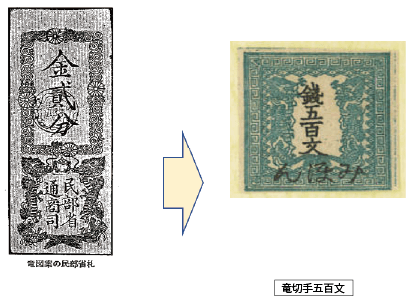1870年9月、太政官から民部省に郵便切手の準備命令が発せられた。民部省(前島密)は切手の製作を正式に松田敦朝に依頼した。切手のデザインは、明治2年以降発行された「太政官札」や「民部省札」 で、「竜図案」と呼ばれるものである。最初の切手はこの「竜図案」が原型となっている。
In September 1870, Daijo-kan issued an order to prepare postage stamps to the Ministry of Popular Affairs.The Ministry of Popular Affairs (Maejima Hisoka) officially asked Atsushi Matsuda to make stamps. The design of the stamp was the same as that of “Daijo-kan Bill” and “Ministry of Popular Affairs Bill” issued after the 2nd year of Meiji, and was called “Dragon Design”. The first stamp was based on this “symmetrical dragon design”.

竜切手の技法は、凹版エッチングである。銅板表面に耐食性薬品を塗布し、被膜を付け、その上に薄い雁皮紙(がんびし)に描いた切手下絵を重ね、針の先で画線部分の耐食膜を削り、画線部同面を表出させ、硝酸で腐食させることにより凹版原版を製作する。印刷技法として、轆轤式(ろくろしき)圧縮ローラー(上下2段)の間に原版とラシャ紙を重ねて刷り込む手法がとられた。当時は一つの原版から多数同版を作成するのではなく、一枚一枚同様のデザインを手彫り製作したので、必然的に全ての切手が同じ様であっても微妙に異なっている。
1872年(明治5)、竜切手の後に発行されたのは、の「桜切手」である。明治政府は、郵便需要の高まりに対応するため、全国の有力者に委託して三等郵便局を開設した。 同年7月、竜切手に代わる新図案の一色刷り手彫切手が発行された。10銭以上は主に外国郵便に使用された。四隅に桜がデザインされ、図案にはローマ字表記(Sen)が加えられた。1873年(明治6)、郵便ルートがほぼ全国に拡大したことを契機に、改正郵便規則が交付され、全国均一の郵便料金(従量制)となった。その同時期、膨大となった切手の売上管理と各郵便役所の切手売上金虚偽報告を防止する目的で、桜切手の隅に仮名を入れることになった。1875年(明治8)、「仮名文字」が廃止された。理由は、仮名による分別管理効果が薄いと判断されたためである。
一方、政府はこの頃、郵便の普及による切手の大量需要に対応するため、手彫切手から、電胎盤(でんたいばん)方式による切手製造を計画した。それが1876年(明治9)の小判切手である。
The technique of dragon stamps is intaglio etching, applying a corrosion-resistant chemical to the surface of the copper plate, a film and, overlaying a stamp sketch drawn on thin paper on it, scraping the film of the image part with the tip of a needle, exposing the same surface of the image part, and using nitric acid. Intaglio original plate is manufactured by corroding. As a printing technique, a method of printing the original plate and Rasha paper on top of each other between the foot-operated rotary type (rokuroshiki) compression rollers (upper and lower two stages) was adopted. At that time, instead of making many of the same editions from one original edition, the same design was hand-carved one by one, so inevitably all stamps are slightly different even if they are the same ones.In 1872 (Meiji 5), the “Sakura Stamp” was issued after the dragon stamp. The Meiji government has entrusted influential people nationwide to open a third-class post office in order to respond to rising postal demand. In July of the same year, a one-color hand-carved stamp with a new design was issued in place of the dragon stamp. More than 10 sen was mainly used for foreign mail. Sakura was designed in the four corners, and Roman alphabet (Sen) was added to the design.In 1873 (Meiji 6), when the postal route expanded almost nationwide, the revised postal rules were issued, and the postage became uniform nationwide (pay-as-you-go). At the same time, it was decided to put a hiragana in the corner of Sakura stamps in order to manage the huge amount of stamp sales and prevent false reports of stamp sales at each post office.In 1875 (Meiji 8), “kana characters” were abolished. The reason is that it was judged that the segregation management effect by the hiragana was not effective. On the other hand, around this time, the government planned to manufacture stamps from hand-carved stamps using the electric placenta method in order to meet the large demand for stamps due to the spread of mail. That is the 1876 (Meiji 9) oval stamp.
